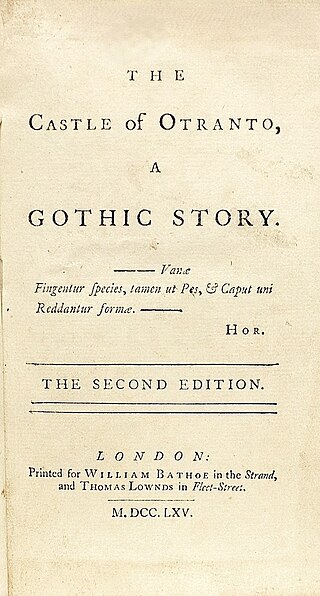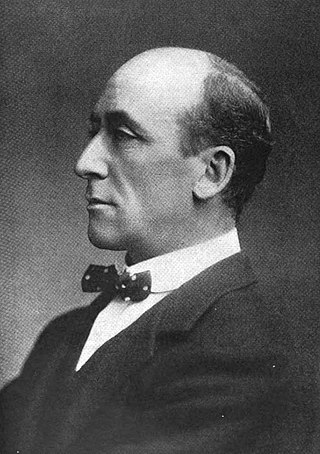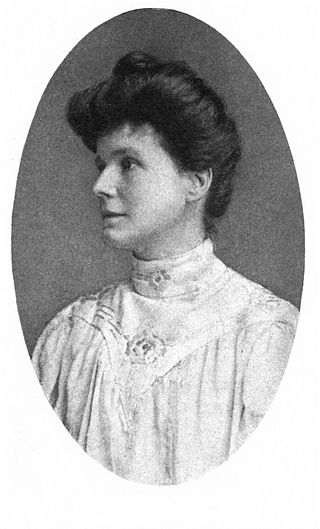
Gothic fiction, sometimes called Gothic horror, is a loose literary aesthetic of fear and haunting. The name refers to Gothic architecture of the European Middle Ages, which was characteristic of the settings of early Gothic novels.

Horror is a genre of fiction that is intended to disturb, frighten or scare. Horror is often divided into the sub-genres of psychological horror and supernatural horror, which are in the realm of speculative fiction. Literary historian J. A. Cuddon, in 1984, defined the horror story as "a piece of fiction in prose of variable length ... which shocks, or even frightens the reader, or perhaps induces a feeling of repulsion or loathing". Horror intends to create an eerie and frightening atmosphere for the reader. Often the central menace of a work of horror fiction can be interpreted as a metaphor for larger fears of a society.

Montague Rhodes James was an English medievalist scholar and author who served as provost of King's College, Cambridge (1905–1918), and of Eton College (1918–1936) as well as Vice-Chancellor of the University of Cambridge (1913–1915). James's scholarly work is still highly regarded, but he is best remembered for his ghost stories, which are considered by many critics and authors as the finest in the English language and widely influential on modern horror.

Ramsey Campbell is an English horror fiction writer, editor and critic who has been writing for well over fifty years. He is the author of over 30 novels and hundreds of short stories, many of them winners of literary awards. Three of his novels have been adapted into films.

Algernon Henry Blackwood, CBE was an English broadcasting narrator, journalist, novelist and short story writer, and among the most prolific ghost story writers in the history of the genre. The literary critic S. T. Joshi stated, "His work is more consistently meritorious than any weird writer's except Dunsany's" and that his short story collection Incredible Adventures (1914) "may be the premier weird collection of this or any other century".

Robert William Chambers was an American artist and fiction writer, best known for his book of short stories titled The King in Yellow, published in 1895.

Erckmann-Chatrian was the name used by French authors Émile Erckmann (1822–1899) and Alexandre Chatrian (1826–1890), nearly all of whose works were jointly written.

A ghost story is any piece of fiction, or drama, that includes a ghost, or simply takes as a premise the possibility of ghosts or characters' belief in them. The "ghost" may appear of its own accord or be summoned by magic. Linked to the ghost is the idea of a "haunting", where a supernatural entity is tied to a place, object or person. Ghost stories are commonly examples of ghostlore.

May Sinclair was the pseudonym of Mary Amelia St. Clair, a popular British writer who wrote about two dozen novels, short stories and poetry. She was an active suffragist, and member of the Woman Writers' Suffrage League. She once dressed up as a demure, rebel Jane Austen for a suffrage fundraising event. Sinclair was also a significant critic in the area of modernist poetry and prose, and she is attributed with first using the term 'stream of consciousness' in a literary context, when reviewing the first volumes of Dorothy Richardson's novel sequence Pilgrimage (1915–1967), in The Egoist, April 1918.
Theodore "Eibon" Donald Klein is an American horror writer and editor.
Herbert Russell Wakefield was an English short-story writer, novelist, publisher, and civil servant chiefly remembered today for his ghost stories.
Jack Sullivan is an American literary scholar, professor, essayist, author, editor, musicologist, concert annotator, and short story writer. He is a scholar of the horror genre, Alfred Hitchcock, and the impact of American culture on European music.
Gary William Crawford was an American writer and small press publisher.
Sir Charles Lloyd Birkin, 5th Baronet was an English writer of horror short stories and the editor of the Creeps Library of anthologies. Typically working under the pseudonym Charles Lloyd, Birkin's tales tended towards the conte cruels rather than supernatural fiction, although he did write some ghost stories.
The Ghost Story Society was a not-for-profit literary society whose members shared an interest in supernatural fiction. Founded in Britain in 1988 by Rosemary Pardoe, Jeffrey Dempsey, David Cowperthwaite and Mark Valentine, it had an international membership and was later administered by joint organizers Christopher Roden and Barbara Roden, owners of Ash-Tree Press, with the assistance of David G. Rowlands, Richard Dalby, Jan Arter, and Roger Dobson. It has not been active since 2007.
William John Metcalfe was an English teacher, short story writer and novelist from Norfolk, who twice emigrated to the United States. His stories have been said to "build up a unique sense of unease."

Stephen Jones is an English editor of horror anthologies, and the author of several book-length studies of horror and fantasy films as well as an account of H. P. Lovecraft's early British publications.
Alfred McLelland Burrage (1889–1956) was a British writer. He was noted in his time as an author of fiction for boys which he published under the pseudonym Frank Lelland, including a popular series called "Tufty". After his death, however, Burrage became best known for his ghost stories.
John Howard is an English author, born in London in 1961. His fiction has appeared in anthologies, magazines, and the collections The Silver Voices, Written by Daylight, Cities and Thrones and Powers, and Buried Shadows. The majority of Howard's stories have central and eastern European settings; many are set in the fictional Romanian town of Steaua de Munte. The Defeat of Grief is a novella set in Steaua de Munte and the real Black Sea resort of Balcic; the novellas "The Fatal Vision" and The Lustre of Time form part of an ongoing series with Steaua de Munte architect and academic Cristian Luca as protagonist. Numbered as Sand or the Stars attempts a 'secret history' of Hungary between the World Wars.
Ron Weighell (1950–2020) was a British writer of fiction in the supernatural, fantasy and horror genre, whose work was published in the U.K., the U.S.A., Canada, Germany, Ireland, Romania, Finland, Belgium and Mexico. His stories were included in over fifty anthologies and published in six volumes containing his own work exclusively. Weighell is listed as an author in the online Bibliothèque Nationale de France, with a selected bibliography. A short biography and limited bibliography are available in the goodreads.com website. A more extensive bibliography of his published work is available in the Internet Speculative Fiction Database. Weighell died on 24 December 2020, some weeks after suffering a stroke. Obituaries have been published by the Fortean Times magazine, the newsletter of The Sherlock Holmes Society of London, and Locus Magazine.










